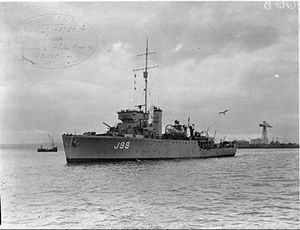HMS Jason (J99)

Jason in 1941
|
|
| History | |
|---|---|
|
|
|
| Name: | HMS Jason |
| Builder: | Ailsa Shipbuilding Co. Ltd., Troon |
| Laid down: | 12 December 1936 |
| Launched: | 6 October 1937 |
| Commissioned: | 9 June 1938 |
| Honours and awards: |
|
| Fate: | Scrapped in 1950 |
| Badge: | On a field Red, a golden fleece. |
| General characteristics | |
| Class and type: | Halcyon-class minesweeper |
| Displacement: |
|
| Length: | 245 ft 9 in (74.90 m) |
| Beam: | 33 ft 6 in (10.21 m) |
| Draught: | 9 ft (2.7 m) |
| Propulsion: | 2 × Admiralty 3-drum water-tube boilers, 2 × geared turbines driving 2 shafts producing 2000 shp |
| Speed: | 17 knots |
| Range: |
|
| Complement: | 80 (peace time) |
| Armament: |
|
HMS Jason was a Halcyon-class minesweeper. She was named after the hero in Greek mythology and was the sixteenth (and as of 2008[update], the final) Royal Navy ship to carry the name Jason. She was laid down on 12 December 1936, launched on 6 October 1937, and was completed on 9 June 1938. She survived the Second World War and was sold in 1946 to become a cargo ship. She was eventually broken up in 1950. Her pennant number was originally N99, but was changed to J99 in May 1940.
Before the war, HMS Jason carried out surveys of the English and Bristol Channels. She carried out two principal surveys during 1938 and 1939. She was unarmed until the outbreak of the Second World War.
Although HMS Jason had been designed as a minesweeper, in September 1939, she was converted into an antisubmarine vessel and assigned to 1st Anti-submarine striking force at Belfast. Her first minor damage sustained was on 12 October when she was grounded at Row Point. Repairs were completed by 17 October and she was deployed in home waters for convoy defence, but she put in for more repairs on 3 August 1940, this time because of problems in her boilers.
After the repairs, she was again deployed to convoy defence, this time in the North West Approaches, during which she came under repeated attack from German U-boats U-32 and U-28. Although HMS Jason was not damaged in the attacks, four merchant ships were lost and Jason picked up 18 survivors. After one month in that role, yet more repairs were needed after a collision with the rescue tug Scheldt, in which significant structural damage to her stem was sustained. This time repairs were completed at HM Dockyard, Rosyth, and she was, upon release, deployed to the Rosyth Escort Force to defend shipping to and from Clyde.
...
Wikipedia
